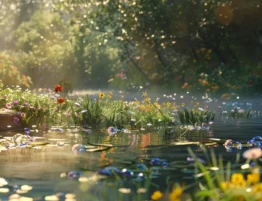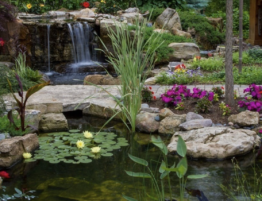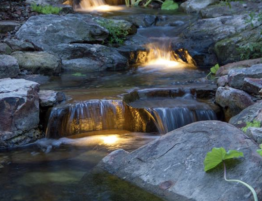Creating and maintaining a beautiful water feature can seem like an overwhelming task, but it doesn’t have to be! Imagine stepping into your backyard, where a serene pond or fountain gleams in the sunlight, filled with colorful fish and vibrant plants. To achieve this stunning oasis, effective filtration solutionsare key. These systems not only help keep the water clear and healthy but also support the entire ecosystem of your pond or fountain. Let’s dive into the benefits these systems offer and explore some simple maintenance tips to ensure your aquatic haven remains a source of joy for years to come.
Filtration solutions are essential for a healthy water feature as they remove harmful solids, chemicals, and pathogens, ensuring clean and clear water that supports aquatic life. Effective filtration not only enhances water quality but also contributes to the overall aesthetic appeal of your pond or fountain, promoting a balanced ecosystem that reduces maintenance efforts over time.
Importance of Filtration
Filtration systems are not merely optional luxuries; they are the lifeblood of healthy water features. Without effective filtration, water can quickly devolve into a swirling mass of algae and harmful bacteria, creating murky waters that are both unpleasant to look at and dangerous for aquatic life. The consequences can be severe: foul odors may emanate from stagnant pools, while fish and plant health plummet dramatically in these unclean conditions. A well-maintained filtration system stabilizes the water quality, ensuring clarity and cleanliness, which directly influences the overall aesthetic appeal of your pond.
Additionally, it’s important to consider that while some may argue that natural ponds can survive without mechanical filtration, this belief doesn’t account for the unique challenges faced by artificial water features. Unlike natural ecosystems that possess a self-regulating balance due to their size, depth, and surrounding environments, smaller ponds often lack such intricate biological processes. They therefore depend heavily on human intervention—chiefly through filtration—to maintain stability and biodiversity.
Think about it: if you were dropped into an unfamiliar environment without proper resources or tools, your ability to thrive would be significantly compromised. For our beloved aquatic friends—the plants and fish in our ponds—the situation is no different.
Research supports this assertion strongly. In fact, a study published in the Journal of Environmental Managementrevealed that water features equipped with inadequate or poorly maintained filtration systems experienced a staggering 70% increase in algal blooms during the hotter summer months compared to those with effective systems in place. This means not only unsightly green waters but also higher costs associated with maintenance and restoration—factors that no pond owner wants to face.
Beyond just avoiding algae and bacteria, a functioning filtration system is key to enhancing oxygen levels in the water. When pumps circulate water effectively, they boost oxygen availability, which is vital for both the beneficial nitrifying bacteria and aquatic life. Just as we need fresh air to breathe, so too do our fish and plants require clean, oxygenated water to thrive.
Additional Benefits of Maintaining an Effective Filtration System
- Clear Water:It reduces particulate matter, leading to sparkling clear surfaces.
- Healthier Fish:Provides stable conditions that support overall fish health.
- Reduced Maintenance Needs:Efficient systems can lower the necessity for chemical treatments by up to 60%, promoting a more natural ecosystem.
By prioritizing regular maintenance on your filtration system, you’re not just improving aesthetics but actively contributing to the longevity of your water feature. It extends the lifespan of pumps and equipment by reducing wear and tear—up to 40%, according to field studies—ensuring your investment continues to flourish beautifully year after year. Engaging in this practice isn’t merely practical; it’s an essential duty for any responsible water feature owner committed to sustainability and beauty.
With those foundational benefits established, we can now turn our attention towards understanding the mechanisms behind these essential systems and how they contribute to a thriving aquatic environment.
Mechanical Filters Explored
When we talk about mechanical filtration, we’re discussing a crucial step in ensuring your pond remains a shimmering oasis. These filters function as the first line of defense by physically trapping debris, dirt, and other unwanted particles from the water. Imagine a net scooping up leaves and twigs before they sink to the bottom—this is essentially what mechanical filters do! Common types include mesh screens, foam pads, and advanced options such as the ProfiDrum automatic drum filter.
Each category of mechanical filter has its own strengths and applications. For instance, mesh screensare quite straightforward; they act like strainers to catch larger debris while allowing water to flow freely through. However, if you’re looking for efficiency, foam pads often rise to the occasion by offering a higher surface area that captures smaller particles more effectively. They’re a great option if you want a balance between filtering capabilities and maintenance demands.
It’s important to note that while mechanical filters do a commendable job capturing solid waste, they can’t tackle dissolved materials like ammonia or nitrates—this is where biological filtration complements their efforts.
Here’s how some popular mechanical filters stack up against each other:
| Filter Type | Efficiency | Maintenance | Cost |
| Mesh Screens | Medium | Low | Low |
| Foam Pads | High | Medium | Medium |
| Automatic Drums | Very High | Low | High |
The efficiency of these filters varies significantly. For instance, automatic drum filtersprovide exceptional filtration capabilities with minimal human intervention thanks to their self-cleaning mechanisms. Although they can be pricier upfront, the investment pays off in reduced labor and increased long-term effectiveness. They’re especially well-suited for larger ponds where maintaining water clarity is paramount.
With this understanding of mechanical filtration established, we can now explore the complementary role played by biological methods in fostering a healthy aquatic environment.
Biological filtration methods
At its core, biological filtrationacts as the natural recycling system for your pond. Imagine it as nature’s very own cleaning crew comprised of beneficial bacteria that work tirelessly to break down waste. When organic matter such as fish waste and decaying plants amass in the water, they produce harmful substances like ammonia, which can be toxic to fish. Thankfully, these beneficial bacteria swoop in to save the day by converting ammonia into less harmful nitrites and eventually nitrates, which are far less toxic.
You might wonder how this process works in practice. It starts when you introduce a biological filter into your pond setup. This filter serves as a home or habitat for the beneficial bacteria that will thrive in it. By establishing a thriving colony of these microorganisms, you effectively create a sustainable ecosystem where waste isn’t just swept away; it’s actively decomposed and transformed into substances that aquatic plants can use as nutrients.
A gram of biological filter media is impressive enough to harbor countless bacteria capable of processing up to 3 milligrams of ammonia per day! This illustrates the substantial impact biological filtration has on water quality and overall fish health.
Choosing the Right Biological Media
To achieve optimal results with biological filtration, choosing the right type of media is essential. Some common forms include ceramic rings, bioballs, and plastic media. Each type has its own unique characteristics and contributes differently to the filtering process.
- Ceramic Rings: These are porous, allowing for a large surface area for beneficial bacteria to colonize while maintaining water flow.
- Bio Balls: These lightweight spheres are excellent for promoting aeration plus offer substantial space for bacterial growth.
- Plastic Media: Resilient and less prone to decay than organic materials, plastic media can also provide efficient filtration without taking up too much space.
With an understanding of how biological filtration functions and what media works best, it’s crucial to consider how well your pump operates, as proper circulation ensures these filters work effectively. The synergy between filtration systems and pump performance plays a pivotal role in achieving clear, healthy water.
Effective Pump Utilization
The pump truly is the heartof any effective filtration system. It’s not just about moving water; it plays a crucial role in maintaining the health and vibrancy of your fish ponds, water gardens, and waterfalls. A quality pump ensures continuous circulation, which prevents stagnation that could lead to algae growth and an influx of unwanted insects.
When choosing a pump, it’s essential to consider its flow rate—measured in gallons per hour (GPH). For instance, if you have a 3000-gallon pond, you would need a pump with a minimum flow rate of 1500 GPH to ensure the entire volume circulates at least once every hour. This recommendation isn’t arbitrary; it’s based on ensuring sufficient oxygenation for your aquatic plants and fish, providing them with a healthier environment.
Moreover, selecting the right type of pump for your setup makes all the difference. Submersible pumps are often ideal for smaller ponds because they operate quietly and efficiently under water. Conversely, if you’re working with larger installations or complex systems involving waterfalls or streams, external pumps are preferable due to their power and capacity to handle more significant water volumes without compromising performance.
A well-placed pump helps maintain clear water, preventing sediment accumulation that can cloud your pond’s beauty.
In addition to flow rate considerations, pay attention to delivery height. This specification details how high the pump can lift water vertically—the greater the height needed for features like waterfalls or streams, the more powerful your pump needs to be. Think about it: trying to use a garden hose to power a fountain several feet above ground wouldn’t work well! Thus, investing in a capable pump tailored to your landscape is vital.
At Clarity Ponds, we specialize in custom pump solutions designed specifically for various water features. Our offerings excel in energy efficiency and reliability, ensuring that whatever your setup requires, there’s a perfect match available. We’ve found that this personalized approach not only meets the filtration needs but also creates an aesthetically pleasing installation that’s simple to manage.
Keep Your Pump Clean
Regular maintenance of your pump will also extend its life and efficacy; dirt and debris can hinder performance over time. It’s advisable to clean filters frequently—or at least check them once a month—to allow for optimum flow and uninterrupted operation. Neglecting this aspect can lead to overworking the motor or damaging internal components, requiring costly replacements down the road.
Understanding how to effectively utilize your pump while ensuring routine maintenance sets the groundwork for a successful water feature experience. As we explore further, we’ll look into another natural method that enhances water purity through the use of living organisms.
Natural Water Purification using Plants
Aquatic plants serve as key players in the quest for pristine pond water. These living organisms not only add breathtaking beauty to your water feature but also actively contribute to maintaining its ecological health. By absorbing excess nutrients from the water, plants like water liliesand reedseffectively starve algae of the sustenance they require to proliferate. This means less green muck clouding your pond, allowing you to enjoy crystal-clear waters.
Imagine strolling past your pond on a warm afternoon, noticing how the lush greenery provides shade and a sense of tranquility. As you gaze into the water, it’s simple to appreciate the role these plants play in creating a balanced aquatic ecosystem. One remarkable example is anacharis, a submerged plant that enriches the water with oxygen—a critical element for sustaining healthy fish and beneficial bacteria. It acts almost like a natural air pump, stabilizing your pond’s environment while adding vibrant life beneath the surface.
The charm of integrating flora into your filtration strategy lies in its simplicity. Picture it: a garden of aquatic plants working tirelessly to filter toxins, absorb excess nutrients, and create habitats for wildlife. It’s nature’s own way of circulating life through your pond.
When considering which plants to incorporate into your filtration system, it’s essential to choose varieties that enhance biodiversity while promoting overall water quality. Popular choices include duckweed, known for its ability to rapidly reduce nitrogen levels; cattails, which effectively absorb heavy metals; and phragmites, commonly referred to as common reed, which can filter out pollutants and significantly improve water quality.
With their diverse benefits, these plants not only purify but also provide stunning visual interest, making your water feature a true centerpiece of your landscape. Regularly incorporating these aquatic plants offers additional advantages: they create habitats for microorganisms and aquatic animals like frogs and dragonflies, which are excellent indicators of a healthy ecosystem.
For optimal performance, ensure that the pH levels in your pond are conducive to plant growth—ideally between 6.5 and 8.5—and maintain proper water depths depending on the species you select; some flourish best in deeper areas while others prefer shallows. This attention to detail guarantees that your natural filtration system works harmoniously within its environment.
By understanding how these aquatic plants operate within your pond, you can combine them seamlessly with mechanical and biological filtration systems for an effective, holistic approach to maintaining clean water in your feature.
As we shift focus now, let’s explore the necessary considerations you’ll want to keep in mind when choosing the most suitable filtration components for your unique setup.
Selecting the Perfect Filtration System
Choosing the right filtration system for your water feature isn’t simply about picking an option off a shelf; it’s a crucial decision that hinges on various factors unique to your setup. The first variable to consider is size—both of your water feature and its inhabitants. A larger pond with many fish will naturally require a more robust filtering solution compared to a small fountain with minimal aquatic life. Having the right size filter ensures optimal water circulation and cleanliness, promoting a healthy aquatic ecosystem.
Another critical factor is sunlight exposure. Sunlight encourages the growth of algae, so understanding how much light your feature receives can significantly inform your choice of filtration system. For instance, if your pond is bathed in afternoon sun, you might need a filter that not only purifies but also reduces algae blooms effectively. It’s akin to having a garden; you wouldn’t care for sun-loving plants the same way you’d care for shade-preferring ones.
Don’t hesitate to seek assistance during this process; resources are available that can set you on the right path.
Consulting with experts can provide invaluable insights tailored specifically to your needs. When reaching out to professionals, consider discussing key components such as:
- Water Volume: This dictates not only filtration capacity but also influences overall water quality. Filters rated for larger volumes will be necessary if you have a bigger body of water.
- Sunlight Exposure: As previously discussed, knowing how much sunlight reaches your water feature determines which filters can handle potential algae growth efficiently.
- Number of Aquatic Inhabitants: More fish mean more waste; thus, understanding your fish load will help professionals recommend an appropriate filtration size and type.
Insider Tip: Clarity Ponds offers free consultations designed to tailor a filtration solution that meets all your requirements. Speaking with knowledgeable staff can help illuminate options that you might not have considered yet.
Once you’ve carefully selected and installed the ideal filtration system for your water feature, remember that it requires regular maintenance for optimal performance.
Regular upkeep ensures that your chosen filtration system operates at peak efficiency, which is essential for maintaining clear, healthy water conditions conducive to flourishing plant and animal life. Without proper care, even the best systems can falter over time. Setting reminders for periodic checks—checking blockages, ensuring pump functionality, and changing filter media as required—can protect against potential mishaps down the line. Embracing this level of diligence ultimately enhances both the beauty and functionality of your beloved water feature for years to come.
As you maintain the heart of your aquatic haven, focusing on proactive measures will ensure longevity and vibrancy in your water feature. Moving forward, let’s explore effective strategies that will keep everything running smoothly.
Essential Maintenance Strategies
To maintain a healthy filtration system, developing a consistent routine is crucial. For starters, you need to monitor pump operation closely since the pump is the heart of your water feature. If the pump isn’t running as it should, oxygen supply drops, hampering the growth of beneficial bacteria that help maintain a balanced ecosystem within your feature. You may notice decreased water flow or unusual noises; both indicate it’s time to investigate further.
Once you’ve confirmed that the pump is operating smoothly, the next step is to tackle the mechanical filters.
Step 1: Monitor Pump Operation
Your filtration system depends on the pump’s ability to keep water circulating. This process not only moves water through the filter but also ensures oxygenation, which is vital for your aquatic life. If you find that your pump isn’t performing optimally, it could lead to algae growth due to stagnant water conditions and ultimately result in more significant hassles down the line. Regular monitoring will help catch any issues before they escalate.
With an eye on the pump, we can now shift focus to maintaining those all-important mechanical filters.
Step 2: Clean Mechanical Filters
Next up are your mechanical filters; these components play a crucial role in trapping debris such as leaves and sediment from entering your filtration system. A monthly cleaning schedule is ideal for keeping them free from clogging. Start by following manufacturer guidelines for cleaning; typically, this involves removing any accumulated gunk and rinsing the filters gently in pond water instead of tap water—using tap water can inadvertently kill off those helpful microorganisms that reside there. The goal here is to ensure optimal performance without causing unintentional harm.
After cleaning the filters, it’s important to take a moment and inspect biological media—a key component that supports beneficial bacteria growth.
Step 3: Inspect Biological Media
The biological medium serves as a breeding ground for beneficial bacteria that help break down waste products and maintain water clarity. If you notice a reduction in flow rates, it’s time for some maintenance. Carefully rinse the biological media using pond water; avoid using tap water as it can contain chlorine or chloramines that may eliminate those helpful bacteria. A gentle rinse clears away accumulated particles while preserving the health of your ecosystem.
Remember that these maintenance steps aren’t just chores; they serve as protective measures to prolong the lifespan of your filtration system while ensuring that your water feature remains visually appealing.
So if you want clear, beautiful water and an efficient system, get into a maintenance groove! Not only will your water feature sparkle, but you’ll also save time and money on repairs by addressing small issues before they grow into larger problems.
As you refine your approach to keeping your filtration system running smoothly, consider how clarity enhances not just aesthetics but also overall health and vitality within your aquatic environment.
Advantages of Clear Water
Clear water is significantly more than just a beautiful sight; it serves as an indicator of a robust aquatic habitat. When your pond showcases sparkling, clear water, it reflects the efforts you’ve put into maintaining a healthy ecosystem. Healthy fish and aquatic plants flourish in an environment free from debris and pollutants, contributing to the overall vitality of your water feature. In this inviting setting, your backyard becomes an enchanting retreat for you and your guests.
Imagine hosting friends for a summer barbecue, where breathtaking views of your well-kept pond steal the show. The clear waters shimmer under the sunlight, allowing everyone to see colorful koi gracefully swimming underneath the surface. This visual appeal adds immense value to your property, potentially increasing its worth by up to 15%in some cases. Guests are often enchanted, taking photos that capture both the beauty of your pond and the happiness shared during those moments spent together.
Embedding transparency within your pond boosts visibility, making it easier to appreciate scenic elements like fish gliding through the water or delicate water lilies floating nearby.
Regular maintenance of filtration systems enables this crystal-clear state to be maintained over time. Aquatic plants serve a dual purpose: they detoxify the water while adding texture and color to the landscape. It’s this blend of function and aesthetics that makes investing in effective filtration essential for anyone looking to create or preserve a pristine aquatic habitat.
Therefore, invest in a quality filtration system for both beauty and functionality, making your water feature the pride and joy of your outdoor space. For more details, visitClarity Ponds.
In conclusion, embracing smart filtration solutions not only enhances the beauty of your outdoor area but also ensures a thriving aquatic environment. To learn more or to embark on your journey toward a stunning water feature, contact us atClarity Pondsor call us at 618.979.4474.







